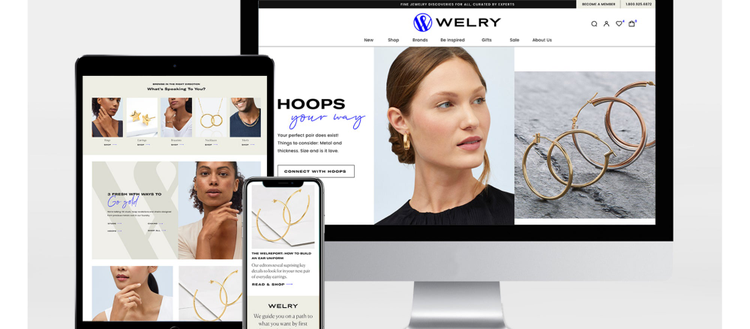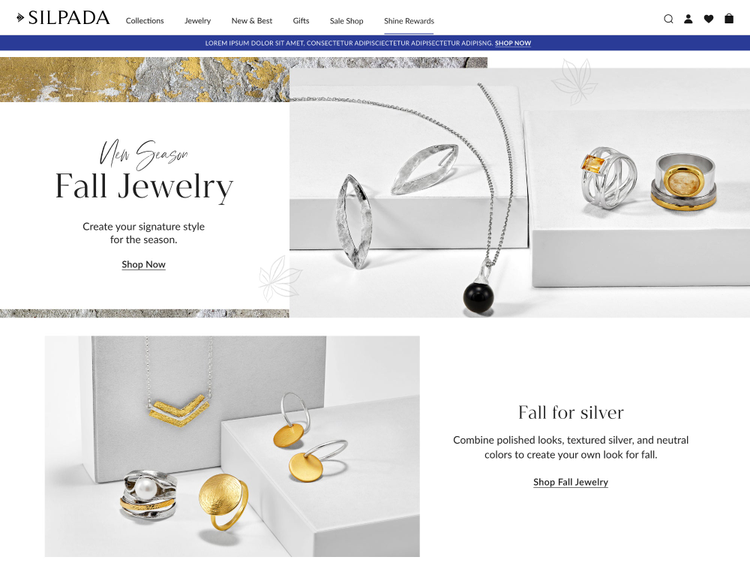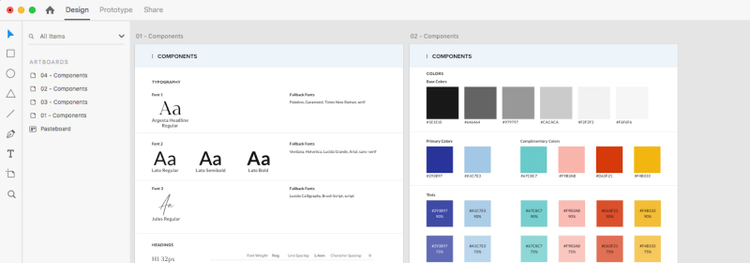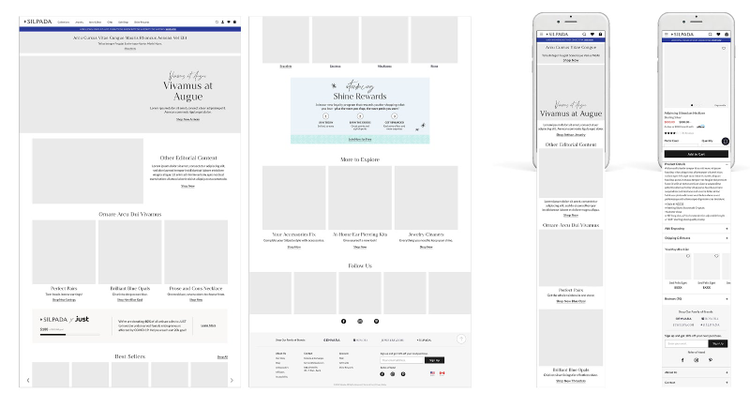When it comes to the sale of luxury goods, you don’t get much fancier than jewelry, and in terms of jewelry manufacturers and service providers, you don’t get much bigger than Richline Group, a Berkshire Hathaway company and one of the largest B2B and DTC vertically integrated fine jewelry manufacturers in the world. Our holding company encompasses Richline Digital, among other divisions, which is focused on digital innovation and launching e-commerce experiences for the group’s jewelry brands, including Silpada.com and Welry.com.
As creative director of Richline Digital, I spend much of my day working to build trust with our online clients through digital experiences. In fact, I’d say trust building is the biggest part of my job. We are constantly working to be creative and bring newness to online shopping. Of course, jewelry e-commerce certainly needs to look and feel good, but none of that matters if there isn’t customer trust. We strive to create the kind of online experience where a customer is just as comfortable buying a pair of $100 earrings as they are buying a $10,000 engagement ring.
Here’s how we build customer trust and how Adobe XD helps us along the way.
Adobe XD
Create and share realistic prototypes, designs for websites, mobile apps, voice interfaces, games, and more.
Learn more
Consumer habits were already in significant flux earlier this year, and then COVID-19 happened. The growth of direct-to-consumer (DTC) engagement and retailing has rapidly accelerated since the pandemic began. As customers are spending more time at home, they’re preferences have switched from in-person to online purchasing, especially in jewelry.
At the same time, there has also been a huge retail disruption, with many key brands and big retailers disappearing. One of the challenges for us has been to cater to demographics that were not necessarily comfortable with online shopping before. New clients are converting to the digital landscape and there is a huge market share and great opportunity for new players. At Richline Group, we are an authority in the jewelry space, providing a destination for every category of jewelry, so we’ve been using design to welcome these new consumers into the fold. This has meant overhauling many of the ways we work, improving how we manage assets and deliver effective experiences — fast.
The unique UX considerations of designing for jewelry e-commerce
Jewelry is an interesting industry with its own unique UX considerations and challenges. The online jewelry buyer has many distinct purchasing journeys driven by different occasions, from trends, to gifting, to special life moments. There is a big emotional connection when it comes to buying jewelry, especially when it’s for an occasion like an engagement or wedding. Also, demographics by gender is not as pronounced as in other verticals. Surprisingly, brand is not a main decision factor either for online jewelry purchases. At this time of increased e-commerce and more demand for digital experiences as a result, understanding these considerations has been more important than ever.
To speak to our consumers and build trust, we focus first and foremost on creating experiences that are both transactional and add value. We also help customers navigate and learn at every stage of the journey, regardless of their browsing styles. Part of Richline Digital’s signature design is ensuring that our online experiences are dynamic and fun, while providing trust and value at every stage of the journey to build a long-term relationship with our audience. We use copy and other design elements to clearly communicate the story behind what the customer is buying — everything from the origin of the gems and metals to the process that went into making this piece of jewelry remarkable.
We recently did a brand refresh for our Silpada brand, using Adobe XD to improve our UX abilities and approach. Our designers were fully converted to XD in a few weeks due to their experience using other intuitive Adobe tools. We transitioned our editorial content to HTML live text, and the experience has been seamless.
All-in-all, XD helped us streamline the creative process and improve efficiency between cross-functional teams.
A new design system for a new type of consumer
In order to meet increased demand for designed experiences, brought on by a sudden major boost in the number of consumers on the jewelry e-commerce sites we design for, we needed a system that would keep us efficient.
One of my top priorities was to find one common tool that was cloud-based, and where project files were optimized for sharing and collaboration. Our creative team works out of multiple locations, and we support many different clients, many of which sell jewelry exclusively online. So, remote collaboration has always been important to us. But now, we are all working from different locations, including our homes.
This is why we adopted XD as a way to facilitate easy communication of design ideas within the creative team. Additionally, by sharing and collaborating on designs in XD, we’re able to facilitate dialogue between our product design team and print/digital content designers. This has mostly been by creating and distributing standardized design systems for the e-commerce experiences we’re responsible for.
One of the major benefits of transitioning our design teams to Adobe XD was that the learning curve wasn’t very steep. Our teams are already using other Adobe products in their workflows, and that meant they could start using XD right away, learning most of the tools and workflows fairly quickly. XD is integrated with Illustrator and Photoshop and can easily convert other files, so it’s been a breeze to deal with assets and multi-tool workflows. We were previously using InVision and Sketch — having to constantly switch tools was a pain.
We’ve also seen a big improvement in the review process for our designs. Now team members and stakeholders are adding comments directly within prototypes. Internal customers are more excited by this process, since it’s visually engaging, and they get to see a dynamic, working prototype versus a static image. Our internal review process is more consumer-centric, and being able to communicate how the finished product will look and feel has been beneficial to delivering experiences across Richline’s product channels.
This accomplishment is a game changer, according to our XD strategic development manager, Jamie Nuzbach, who helped us get here. “XD has allowed Richline to pivot quickly, obtain buy-in from their stakeholders, collaborate better with engineering, which gets projects developed quicker and allows them to capitalize on changing consumer purchasing behaviors,” Nuzbach says.
Smoother designer-developer handoffs
Our goal as a UX team is to build a highly efficient creative workflow and design system that can be used across multiple disciplines and fully integrated across experiences. One of the challenges we’ve faced in accomplishing this has been the handoff process to the development team.
Servers are sometimes slow between different locations, and our company’s workflow solution does not host heavy or large files. XD has helped streamline this process by allowing us to share files with our dev teams by exporting a link directly. This means there is no need to spec out details or make long image files, which can be very time-consuming for designers. The development team has everything they need in one link, including CSS specifications, and there is no need to share heavy files.
The future of UX and product design in e-commerce
Richline Digital is a small multidisciplinary creative team, and we’re continually working on multiple sites and projects at any given time. As a creative leader, my focus is on my team and how we work together. To create an efficient holistic design team, we need to continue to integrate UX designers with the digital/print designers. But that is not all that’s in store for us.
We’re rebranding and improving our mobile-first design strategy on existing and new direct-to-consumer sites. We are constantly looking at current user flows using XD and creating new design systems, components, and toolkits as well as converting our existing templates from Photoshop and InDesign to Adobe XD to make things even smoother.
I believe that it should be a top priority for design tools to constantly improve, looking for ways to help non-technical designers deliver best-in-class digital experiences that can seamlessly translate to different digital platforms. That’s exactly what we’ve seen with Adobe XD. We’ve been able to drive innovation by focusing on creative strategy, first and foremost.
The Adobe XD design journey has opened many possibilities for us at Richline Digital. We are continuing to bridge the gap between creativity and technology to deliver unique, dynamic, and fun experiences, all in a space that really demands that.




